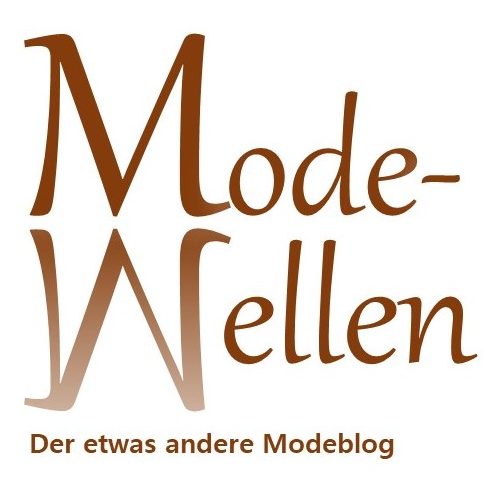The phenomenon of “pregnancy fashion”
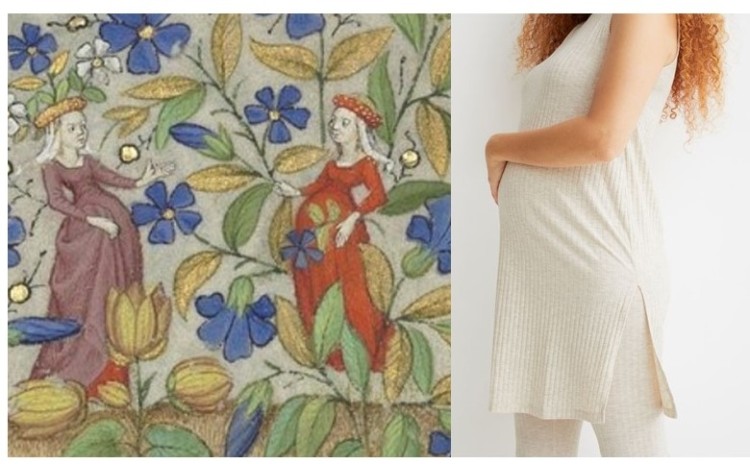
At the end of the 1st century A.D., the satirist Juvenal depicted everyday life in ancient Rome in various themes and devoted a chapter to women. In it, he describes that the vain Roman women often feigned pregnancy and then laid children they bought from poor parents in their husbands’ nest. An artificially created belly with the help of pillows raises an interesting question: did women in times when contraception was not yet commonplace openly flaunt a pregnancy as a positive event or preferred to conceal it? Clothing always played a remarkable role as an aid in both cases. In our days, when every belly bulge (whatever its origin) wants to be concealed with the help of clothing, the fashions summarized below seem even more curious.
The first prominent emphasis on the abdomen occurred in the late Middle Ages, especially in the years from 1400 to 1435. While the cotte and cothardie, worn over the body, already covered it with wide panels of fabric, the houppelande, as the third layer of fabric, increased the volume and train length of the skirts even more. While the waist slipped up and was accentuated by belts, everything underneath was gathered to look like a draped pregnancy belly. This impression is often reinforced in pictorial sources by the posture of the women: they are depicted leaning back slightly, hips thrust forward, sometimes their hands rest on the upwardly gathered, puffy bundles of fabric. Today, when female celebrities are caught by paparazzi with a hand resting on their stomach, the rumors are immediately numerous. Likewise, today, many viewers of Jan van Eyck’s famous Arnolfini Portrait still suspect pregnancy behind the wife’s gestures, although it is almost certainly just a contemporary fad.
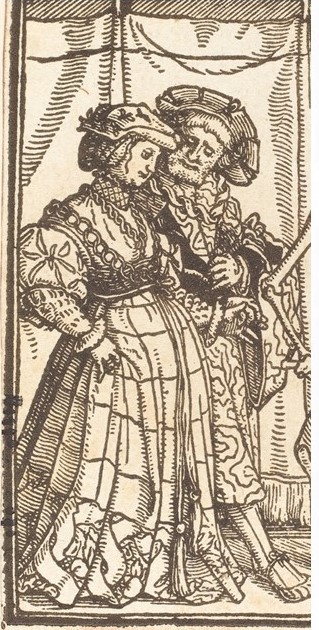
Due to the religiously based cult of the mother or the Virgin Mary, which was particularly widespread in Catholic regions, a fashionably emphasized belly can be interpreted as an appreciation of motherhood. In real everyday life, however, an ambivalent attitude toward pregnancies prevailed. In most cases, depending on class and family situation, they were unplanned. After all, it was an expression of a physical condition visible to all, a display of lived sexuality and thus a subject fraught with shame. Over the course of time there were certainly garments that were cut wide enough to conceal a possible pregnancy. For example, the loose-fitting dress robe called Adrienne, popular in 1703-30, or the robe á la lévite worn by Marie Antoinette during pregnancy. Last but not least, the corset pushed the growing belly backwards, even if it could be gradually loosened by lacing the sides. Removing the corset entirely to allow the baby bump to grow freely, however, was not an option until the 20th century.
The next veneration of the abdominal bump took place at the end of the 18th century, in 1793. What women had long tried to conceal in a cumbersome manner was now suddenly demonstrated with the so-called „pregnancy fashion“. While at the same time in the rest of Europe the natural waist and the usual stiff silhouette still dominated, in England this particular trend apparently developed all by itself. There, so-called ventres postiches (literally: false bellies) in the form of pads were strapped around the belly, after the same pads had formed the Cul de Paris a few years earlier. As is often the case, this idea was ridiculed as a „fashion folly“ with all sorts of mockery and satire. One cartoon exaggeratedly shows ladies in the store choosing between different stages of pregnancy for their belly pads. There are various explanations, including historical ones, for these literal excesses: One says that the pads were meant to keep warm in winter and thus protect against illness. Another saw a pregnant duchess as a trendsetter. It is true that the exaggerated drapery disappeared again quite quickly. What remained, however, was the upswept waist, which set the tone for the following decade.
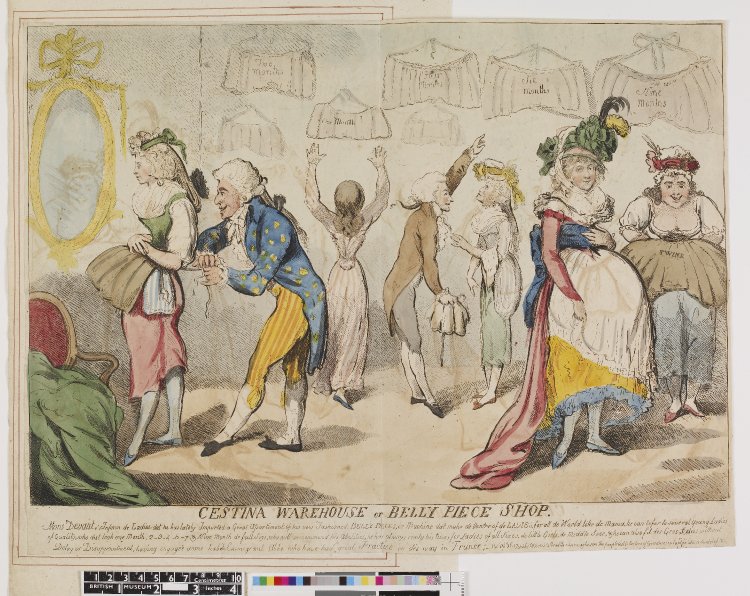
The „pregnancy fashion“ appeared again around 1913, this time in France: As the german author Norbert Stern reports in his book „Mode und Kultur“ („Fashion and Culture“) published in 1915, the maternal silhouette is said to have been linked to the decline in birth rates, which was widely discussed in the media. Many blamed fashion and its beauty ideal of a skinny girl figure for the population decline. The so-called Sens-Ventre line of the 1910s made any possible belly line disappear. According to Stern, France had extended the military service period from two to three years in response to the increased German army. Seeing the shortage of young people the question of where recruits would come from directly affected the well-being of the whole nation. Now it was up to the mothers to come to the aid of the state. The socio-political problem was materialized: The dresses with drapery on the belly were to send a message to all women that there was no need to be ashamed of pregnancy. On the contrary, everyday fashion was now to remind people at all times of the duty of motherhood, which in turn promised new soldiers for France. In 1914, a german women’s magazine mentions the new silhouette: Since the hobble skirt introduced by Paul Poiret simultaneously constricted the legs, the woman now looked like a „swinging blooms on a flower stem“ – a rather euphemistic paraphrase of the newly created figure.
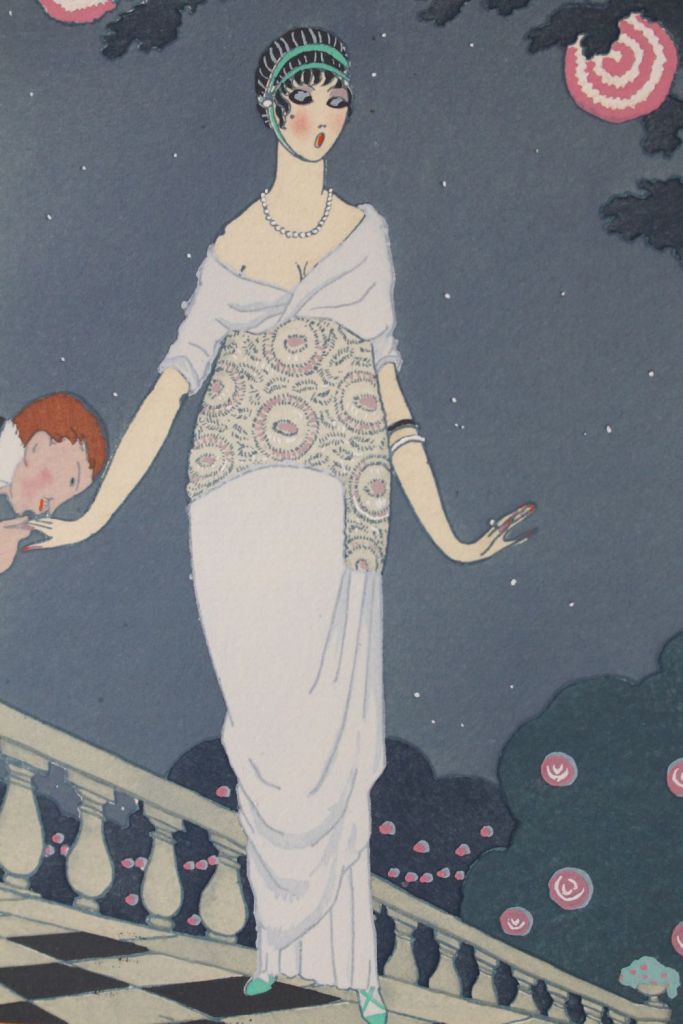
At the beginning of the 15th and the end of the 18th century, women did not want to appear skinny. A round belly signaled prosperity and fertility – both of which women wore outwardly with pride. Today, jeans with the misleading prefix „mom“ flatten the belly. In general, trained bellies are presented freely with preference. The round little belly after a sumptuous meal, on the other hand, is carefully hidden. No one would think of padding an extra ball. In contrast to the past it is now possible to respond to a real pregnancy in a fashionably appropriate way. While many women in recent years were happy to resort to special maternity fashions, with the current comfortable plus-size trends, you can simply leave your closet as it is. This has positive effects on the wallet, the environment and perhaps even on the birth rate….
